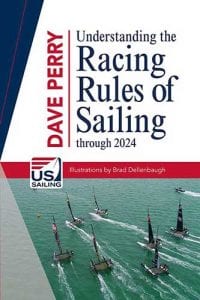1. Why do the racing rules change every four years?
The racing rules are locked in place for a four-year period, and can be changed the year after the Olympics. That keeps the rules from changing
every year, as they do in most sports, but allows World Sailing to improve the rules as the sport evolves.
2. Sometimes the rules revisions are revolutionary and change the way we play the game, and sometimes they’re more subtle. Which would you say the 2021-2024 rules changes are?
There are no “revolutionary” changes in the 2021-2024 rules, but there are many small changes that have improved the sport, made it safer, and made it fairer.
3. Which changes do you think may be the most challenging for sailors to get used to?
Likely the most challenging will be that under the 2021-2024 rules, an item that is listed in the Notice of Race no longer needs to be listed in the Sailing Instructions. Therefore, if sailors do not read the Notice of Race, they may not know important information such as whether there will be a throw-out race or even what the courses are.
4. Which changes do you think will lead to the most interesting boat-on-boat encounters on the race course?
The only real change to the boat-on-boat rules is that now a starboard-tack boat (S) can luff towards a port-tack boat (P) that is sailing to pass astern of her on a downwind leg (not on an upwind leg). S still has to give P room to keep clear of her under rule 16.1, Changing Course, but S can make it more difficult for P to pass astern of her.
5. Which changes do you think will most affect the way race committees run races?
The biggest change for race committees is that now a boat’s crew and equipment is no longer a factor for deciding if a boat is over the starting line at the start, or has crossed the finishing line at the finish. It is just the boat’s hull that counts. So race committees can ignore the boat’s crew, even if they are out on the trapeze at the start, and will no longer have to decide whether a boat’s spinnaker was in its “normal position” in close finishes.
6. What advice would you give to new racing sailors who want to get the greatest competitive advantage they can from the rules?
When new to the sport, the first step is to be solid on the right-of-way rules so you can get near other boats without incorrectly interfering with them. The four r-o-w rules are port/starboard (rule 10), windward/leeward (rule 11), clear ahead and clear astern (rule 12) and tacking (rule 13). The port-tack boat, windward boat, boat clear astern and tacking boats must keep-clear. The other boat in the rule is the right-of-way boat. Be sure that if you are the right-of-way boat that you are not “talked out of your position” by a loud keep-clear boat.
7. How have the new rules changed the way that team racing is played?
The change to rule 16.2, Changing Course, means that starboard-tack boats can no longer “hunt” port-tack boats (bear off and make it more difficult for port-tack boats to duck them).

